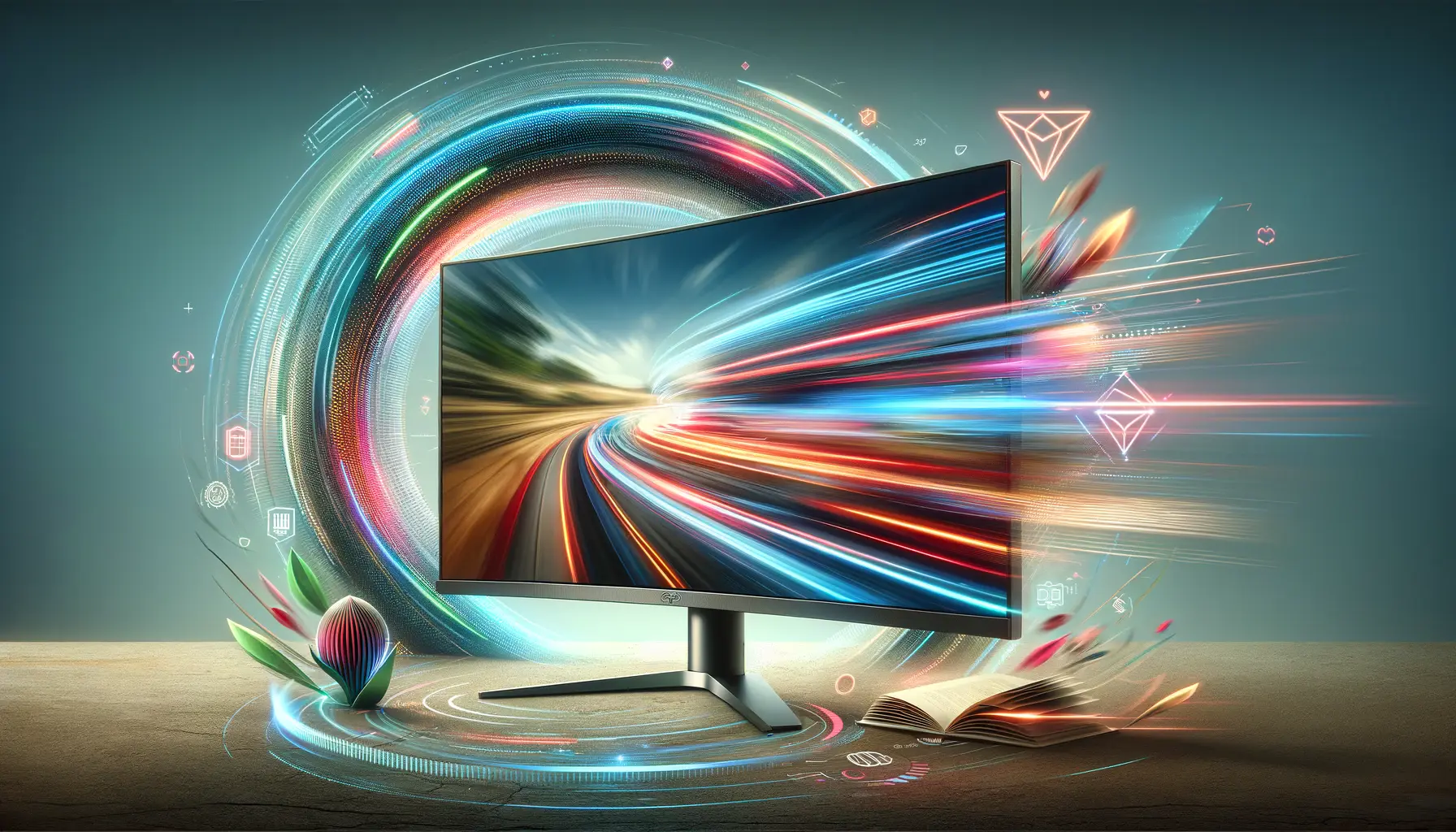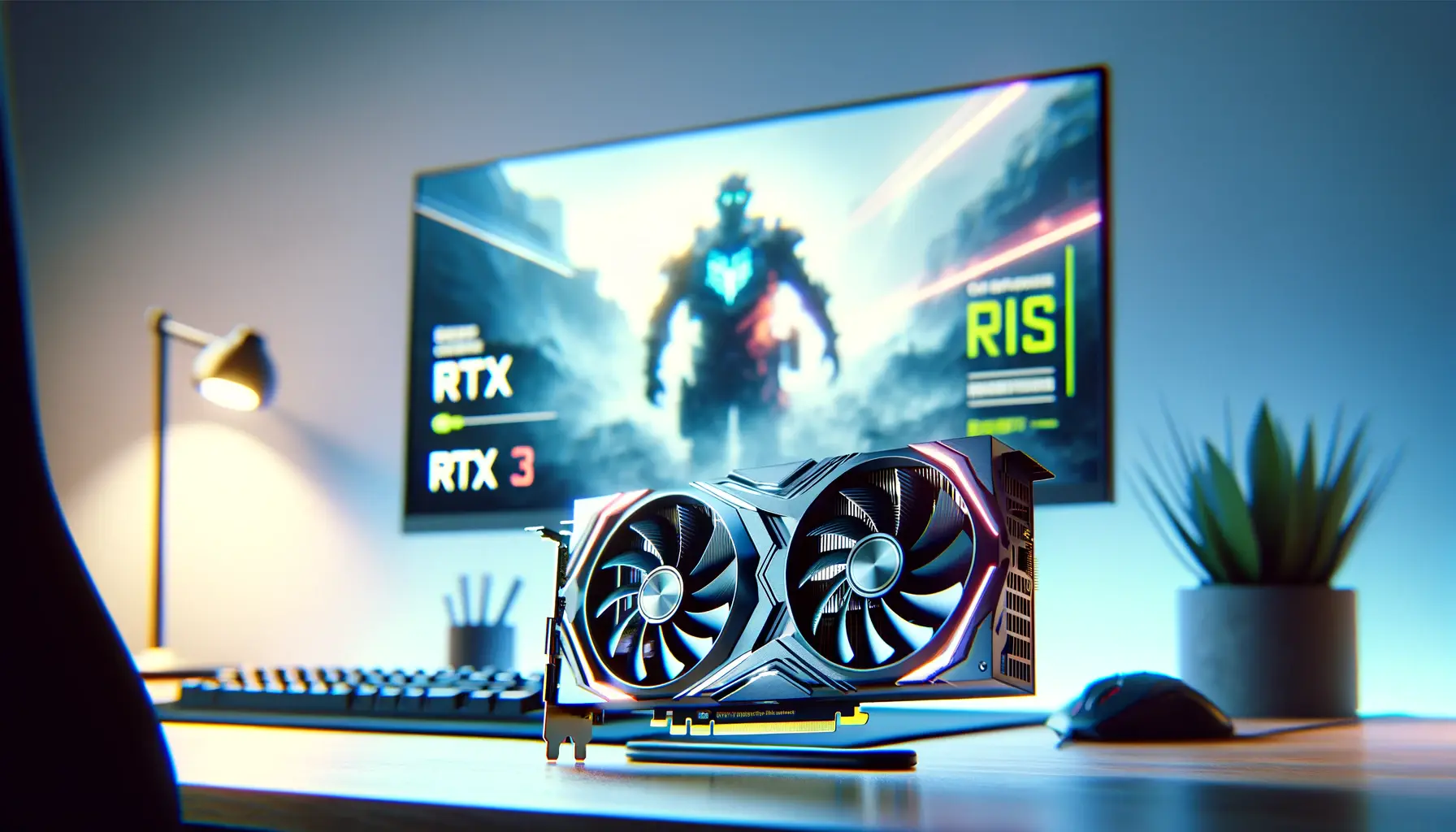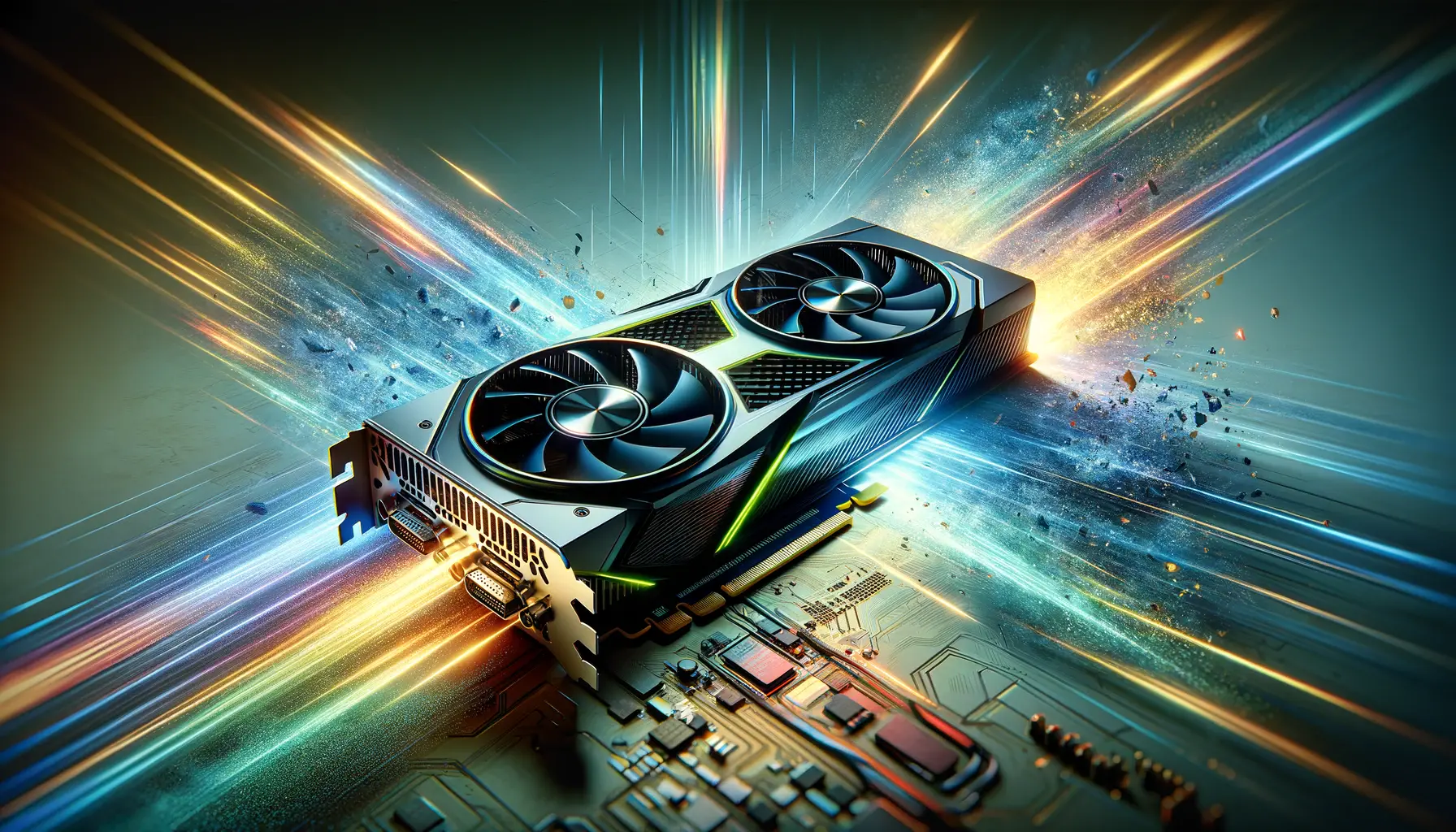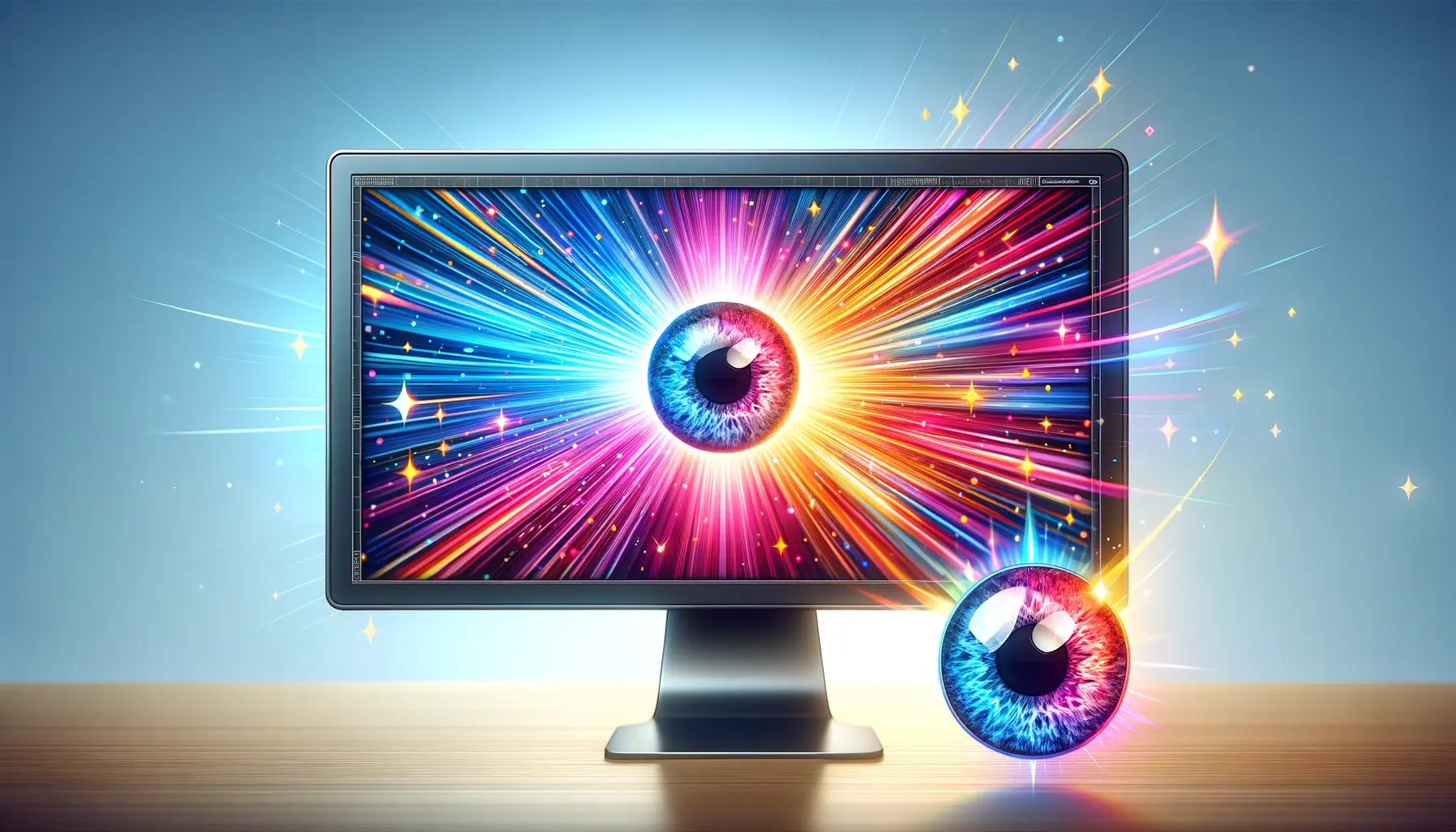Deep Learning Super Sampling (DLSS) 3, NVIDIA’s groundbreaking technology, has been a game-changer for gamers and professionals alike, offering a unique blend of high-quality visuals and performance enhancements.
This technology, specifically designed for high refresh rate monitors, leverages artificial intelligence to upscale images in real-time, allowing for smoother gameplay and sharper graphics without the traditional performance penalty.
As the gaming community continues to evolve, with a growing demand for higher frame rates and better visuals, DLSS 3 stands out as a pivotal innovation.
The integration of DLSS 3 into the gaming ecosystem marks a significant leap forward, especially for users of high refresh rate monitors.
These monitors, which can display more frames per second, provide a more fluid and immersive gaming experience.
However, achieving high frame rates at high resolutions has always been a challenge, often requiring significant hardware investments.
DLSS 3 addresses this challenge head-on, enabling gamers to enjoy the benefits of both worlds: high resolution and high frame rate, without the need for top-tier hardware.
Dive to this guide now!
- DLSS 3 and Its Impact on Gaming
- Guide: Optimizing Settings for DLSS 3
- Comparing DLSS 3 with Previous Versions
- The Role of AI in DLSS 3
- Impact of DLSS 3 on Competitive Gaming
- Future of High Refresh Rate Gaming with DLSS 3
- Maximizing Your Gaming Setup with DLSS 3
- Embracing the Future with DLSS 3
- DLSS 3 FAQ: Enhancing Gaming with AI
DLSS 3 and Its Impact on Gaming
What is DLSS 3?
At its core, DLSS 3 is an AI-driven rendering technology developed by NVIDIA.
It builds upon the previous iterations of DLSS, but introduces a novel feature: frame generation.
This technology not only upscales images from a lower resolution to a higher one but also generates intermediate frames.
This process significantly boosts the frame rate, making games look and feel smoother, particularly on high refresh rate monitors where the difference is most pronounced.
The magic of DLSS 3 lies in its use of dedicated AI processors found in NVIDIA’s RTX series graphics cards.
These processors, known as Tensor Cores, are specifically designed to handle AI and machine learning tasks efficiently.
By leveraging these cores, DLSS 3 can predict and generate additional frames, effectively doubling the perceived frame rate in some scenarios.
This results in a more fluid gaming experience, with less input lag and screen tearing, especially beneficial for competitive gaming where every millisecond counts.
Benefits for High Refresh Rate Monitor Users
For gamers with high refresh rate monitors, DLSS 3 is nothing short of revolutionary.
High refresh rate monitors, capable of displaying upwards of 144Hz, offer a noticeably smoother visual experience compared to standard 60Hz displays.
However, driving these monitors at their native refresh rates, especially at higher resolutions, demands considerable GPU power.
DLSS 3 mitigates this by rendering games at a lower internal resolution and then upscaling them, all while maintaining high frame rates that match or exceed the monitor’s refresh rate.
This technology not only enhances the visual fidelity of games but also extends the lifespan of existing hardware.
Gamers no longer need to upgrade their GPUs as frequently to keep up with the demands of the latest titles.
Additionally, DLSS 3’s frame generation capability reduces the perceived latency, a critical factor for competitive gamers who rely on quick reflexes and precise timing.
This combination of high frame rates and reduced latency makes DLSS 3 an essential tool for anyone looking to maximize their high refresh rate monitor’s potential.
DLSS 3 represents a significant advancement in gaming technology, offering a perfect blend of performance and visual quality, especially for high refresh rate monitor users.
Guide: Optimizing Settings for DLSS 3
Adopting DLSS 3 technology for high refresh rate monitors involves more than just enabling it in a game’s settings.
To fully harness its capabilities, users must understand how to optimize their settings for the best balance between performance and visual quality.
This optimization process ensures that gamers can enjoy the highest possible frame rates without sacrificing the visual fidelity that brings game worlds to life.
Optimizing DLSS 3 settings requires a careful balance of in-game options and NVIDIA Control Panel adjustments.
Here’s a step-by-step guide to achieving the optimal setup:
- Resolution and Refresh Rate: Ensure your display settings match the native resolution and maximum refresh rate of your monitor. This is the foundation for maximizing the benefits of DLSS 3.
- DLSS Settings in Game: Most games with DLSS 3 support offer multiple quality settings (e.g., Performance, Balanced, Quality, Ultra Performance). Experiment with these to find the right balance for your system.
- NVIDIA Control Panel Settings: Access the NVIDIA Control Panel and navigate to the ‘Manage 3D settings’ tab. Here, you can fine-tune settings such as ‘Power management mode’ (prefer maximum performance) and ‘Vertical sync’ (off for lower latency).
- Frame Rate Limit: Consider setting a frame rate limit slightly below your monitor’s maximum refresh rate to reduce fluctuations and tearing. This can be done either in-game or via the NVIDIA Control Panel.
Advanced DLSS 3 Features
Beyond the basic settings, DLSS 3 introduces advanced features that further enhance gaming experiences.
One such feature is ‘Frame Generation,’ which works by interpolating frames to increase fluidity.
Another is ‘Ray Tracing,’ which, when combined with DLSS 3, allows for realistic lighting effects with minimal performance impact.
Understanding and utilizing these features can significantly enhance the visual quality and performance of games.
To make the most of these advanced features, consider the following:
- Enable Ray Tracing: If your game and GPU support it, enabling ray tracing in conjunction with DLSS 3 can produce stunning visual effects without a hefty performance penalty.
- Frame Generation: This feature is particularly beneficial for high refresh rate monitors, as it creates smoother gameplay by adding additional frames. Ensure it’s enabled in the NVIDIA Control Panel under ‘Manage 3D settings.’
Adjusting DLSS 3 settings is a dynamic process that varies from game to game. Regularly revisiting these settings can help maintain the optimal balance between performance and visual quality.
Comparing DLSS 3 with Previous Versions
NVIDIA’s DLSS technology has evolved significantly since its inception, with each version bringing substantial improvements in performance and image quality.
DLSS 3, the latest iteration, stands out not only for its advanced AI-driven capabilities but also for how it revolutionizes gaming experiences, especially on high refresh rate monitors.
Understanding the evolution of DLSS and the distinctions between DLSS 3 and its predecessors is crucial for appreciating its impact on modern gaming.
DLSS 1.0, the first version, introduced the concept of using deep learning to upscale lower-resolution images in real-time, allowing for better performance without drastically compromising on visual quality.
However, it faced criticism for its sometimes blurry images and limited game support.
NVIDIA responded with DLSS 2.0, which significantly improved image quality and expanded compatibility.
DLSS 2.0’s use of a generalized AI model also meant it could be easily implemented across more games.
Key Improvements in DLSS 3
DLSS 3 builds upon the foundation laid by its predecessors but introduces groundbreaking features that set it apart:
- Frame Generation: Unlike DLSS 2.0, DLSS 3 adds frame generation to the mix, effectively increasing the frame rate by interpolating new frames. This is particularly beneficial for users of high refresh rate monitors, as it allows for smoother gameplay even in graphically intensive scenarios.
- Improved AI Algorithms: DLSS 3 utilizes more advanced AI algorithms, resulting in sharper images and better overall visual quality. This leap in technology ensures that games not only run smoother but also look better than ever before.
- Broad Compatibility: While DLSS 2.0 improved upon the first version’s game support, DLSS 3 takes it a step further by being compatible with a wider range of titles, including those that are more demanding in terms of graphics and performance.
The transition from DLSS 2.0 to DLSS 3 represents a significant leap forward in rendering technology.
For gamers, this means enjoying high-definition gaming at unparalleled frame rates, making DLSS 3 a must-have for anyone looking to push their high refresh rate monitors to the limit.
The evolution of DLSS technology, culminating in DLSS 3, showcases NVIDIA’s commitment to enhancing gaming experiences through innovation. Its impact on performance and visual quality is a testament to the power of AI in gaming.
The Role of AI in DLSS 3
The integration of artificial intelligence (AI) in gaming has been transformative, and NVIDIA’s DLSS 3 technology is at the forefront of this revolution.
AI plays a pivotal role in DLSS 3, enabling it to deliver unprecedented improvements in both image quality and performance.
This section delves into how AI powers DLSS 3 and the benefits it brings to gamers, especially those with high refresh rate monitors.
At the heart of DLSS 3 lies a sophisticated AI network trained on ultra-high-quality, 16K gaming content.
This network learns from the vast array of data, understanding complex patterns and textures found in games.
When DLSS 3 is enabled, the AI network predicts and generates high-quality frames from lower-resolution inputs in real-time.
This process not only improves frame rates but also enhances the visual fidelity of games, making them look sharper and more detailed.
Enhancing Gaming Performance with AI
The AI-driven approach of DLSS 3 offers several key benefits:
- Increased Frame Rates: By generating additional frames, DLSS 3 significantly boosts the overall frame rate. This is particularly beneficial for gamers using high refresh rate monitors, as it allows them to fully utilize their monitor’s capabilities, ensuring smoother and more responsive gameplay.
- Improved Image Quality: DLSS 3’s AI algorithms are capable of upscaling images with incredible detail, reducing artifacts and enhancing sharpness. This results in a cleaner, more immersive gaming experience that was previously difficult to achieve without sacrificing performance.
- Reduced Latency: DLSS 3 optimizes rendering pathways, effectively reducing input lag. This improvement in responsiveness is crucial for competitive gaming, where every millisecond counts.
The role of AI in DLSS 3 extends beyond just enhancing individual games.
It represents a shift in how game visuals are processed, moving towards a future where AI and machine learning significantly influence gaming technology.
For users of high refresh rate monitors, DLSS 3 offers a glimpse into this future, providing a smoother, more immersive gaming experience that was once thought impossible without high-end hardware.
AI is the driving force behind DLSS 3, transforming gaming experiences by leveraging deep learning to deliver both higher frame rates and improved visual quality.
Impact of DLSS 3 on Competitive Gaming
Competitive gaming, where precision, speed, and responsiveness are paramount, stands to benefit immensely from NVIDIA’s DLSS 3 technology.
The introduction of DLSS 3 has had a profound impact on the competitive gaming scene, offering players a significant advantage by improving both the performance and visual clarity of games.
This technology is especially beneficial for those using high refresh rate monitors, as it allows for smoother gameplay and faster reaction times.
DLSS 3 enhances competitive gaming in several key ways.
Firstly, by increasing frame rates, it ensures that the action on screen is displayed more fluidly, helping players to better track movement and react to fast-paced situations.
Secondly, the improved image quality means that details are sharper, making it easier to spot opponents or important game elements.
Lastly, the reduction in input lag results in a more responsive gaming experience, allowing for quicker decision-making and actions.
Real-World Benefits for Competitive Gamers
The advantages of DLSS 3 for competitive gamers are not just theoretical.
Many players have reported noticeable improvements in their gaming performance after enabling DLSS 3.
Here are some of the ways DLSS 3 impacts competitive gaming:
- Enhanced Visuals: With DLSS 3, players can enjoy higher resolutions without sacrificing frame rates, making it easier to discern distant objects or enemies, a crucial factor in many competitive games.
- Smooth Gameplay: The smoother frame delivery provided by DLSS 3 reduces motion blur and screen tearing, crucial for tracking fast-moving objects or navigating quickly through complex environments.
- Reduced Reaction Times: By minimizing input lag, DLSS 3 helps players to react more swiftly to in-game events, giving them an edge over opponents who may be experiencing slower frame rates or higher latency.
For competitive gamers, every fraction of a second counts, and DLSS 3’s ability to deliver both high-quality visuals and high frame rates simultaneously makes it an invaluable tool.
As competitive gaming continues to grow, technologies like DLSS 3 that can provide tangible benefits to player performance will become increasingly important.
For those looking to gain a competitive edge, understanding and utilizing DLSS 3 could be the key to achieving new heights in their gaming endeavors.
DLSS 3 is revolutionizing competitive gaming by providing smoother gameplay, sharper visuals, and reduced input lag, all of which contribute to a competitive advantage.
Future of High Refresh Rate Gaming with DLSS 3
The advent of DLSS 3 technology marks a significant milestone in the evolution of high refresh rate gaming.
As gamers continually seek smoother and more immersive experiences, the role of technologies like DLSS 3 becomes increasingly crucial.
Looking ahead, the future of gaming with high refresh rate monitors is set to be transformed by DLSS 3, promising enhancements that were once deemed unattainable.
DLSS 3’s innovative approach to rendering, combining AI-driven frame generation with traditional upscaling techniques, paves the way for a new era of gaming.
This technology not only boosts performance but also improves visual quality, setting a new standard for what gamers can expect from their high refresh rate displays.
As developers continue to integrate DLSS 3 into more games, its impact on the gaming landscape will only grow, offering unprecedented levels of fluidity and detail.
Anticipated Developments in DLSS Technology
The continuous advancement of AI and machine learning technologies suggests that DLSS 3 is just the beginning.
Future iterations of DLSS could introduce even more sophisticated algorithms, further enhancing image quality and performance.
Here are some potential developments:
- Even Better Frame Generation: Future versions of DLSS may offer more accurate and seamless frame interpolation, reducing artifacts and making the gaming experience indistinguishable from native high frame rate playback.
- Improved Compatibility: As DLSS technology evolves, we can expect broader compatibility with a wider range of games and genres, including those that traditionally haven’t benefited as much from upscaling technologies.
- Customizable AI Models: There’s potential for customizable AI models that can be trained according to individual preferences or specific game types, offering a more personalized gaming experience.
The integration of DLSS 3 and its future iterations into gaming hardware and software will likely accelerate, driven by the demand for higher performance and better visuals.
For gamers, this means that high refresh rate monitors will become even more effective at delivering a seamless and immersive gaming experience, further blurring the line between virtual and reality.
The future of high refresh rate gaming is intrinsically linked with the evolution of DLSS technology. As DLSS continues to evolve, it will unlock new possibilities for gamers, redefining the standards of performance and visual fidelity.
Maximizing Your Gaming Setup with DLSS 3
For gamers looking to push their high refresh rate monitors to the limit, DLSS 3 offers a compelling solution.
By intelligently balancing performance with visual fidelity, DLSS 3 enables gamers to experience the best of both worlds.
However, to truly maximize the benefits of DLSS 3, it’s essential to consider the broader context of your gaming setup.
This includes hardware compatibility, monitor settings, and even the choice of games.
Ensuring that your gaming PC is equipped with a compatible NVIDIA RTX series GPU is the first step towards unlocking the full potential of DLSS 3.
From there, optimizing monitor settings to align with DLSS 3’s capabilities can further enhance the gaming experience.
Here are some tips for maximizing your gaming setup with DLSS 3:
- Choose the Right Monitor: Opt for a monitor that not only has a high refresh rate but also supports G-Sync, NVIDIA’s adaptive sync technology. This combination ensures the smoothest possible gameplay, with minimal screen tearing or stuttering.
- Adjust In-Game Settings: While DLSS 3 can significantly boost performance, fine-tuning other in-game settings can help achieve the perfect balance between visual quality and frame rate. Experiment with different configurations to find what works best for your setup.
- Stay Updated: NVIDIA frequently releases driver updates that can improve DLSS performance and compatibility. Keeping your GPU drivers up to date is crucial for maintaining optimal performance.
Exploring the Potential of DLSS 3 in Various Genres
DLSS 3’s benefits extend across a wide range of game genres, from fast-paced shooters to visually stunning open-world titles.
By enabling higher frame rates without compromising on visual quality, DLSS 3 enhances the gaming experience across the board.
Whether you’re navigating the intricate details of a sprawling cityscape or reacting to split-second movements in a competitive match, DLSS 3 ensures that your high refresh rate monitor is fully utilized.
As the gaming industry continues to evolve, the importance of technologies like DLSS 3 in enhancing gaming setups cannot be overstated.
By offering a seamless blend of performance and visual quality, DLSS 3 not only maximizes the capabilities of high refresh rate monitors but also sets a new benchmark for what gamers can expect from their gaming experience.
It’s a misconception that DLSS 3 is only beneficial for top-tier gaming setups. In reality, DLSS 3 can significantly enhance gaming experiences across a wide range of hardware configurations, making high-quality gaming more accessible to everyone.
Embracing the Future with DLSS 3
The journey through the capabilities and benefits of DLSS 3 technology, especially for high refresh rate monitors, underscores a significant leap forward in gaming technology.
NVIDIA’s DLSS 3 not only enhances the visual fidelity and performance of games but also redefines what gamers can expect from their hardware.
As we’ve explored, the integration of AI and deep learning into gaming through DLSS 3 offers a glimpse into the future of gaming, where the balance between performance and visual quality is no longer a trade-off but a harmonious blend.
The Pinnacle of Gaming Performance
DLSS 3 stands as a testament to NVIDIA’s innovation in the realm of gaming technology.
By leveraging AI to predict and generate frames, DLSS 3 allows gamers to experience their favorite titles in unprecedented detail and smoothness, pushing high refresh rate monitors to their full potential.
This technology not only benefits the hardcore gamer seeking the competitive edge but also the casual player looking for a more immersive and visually stunning gaming experience.
Looking Ahead: The Evolution of DLSS
The evolution of DLSS technology, from its initial iteration to the groundbreaking DLSS 3, highlights a trajectory of continuous improvement and innovation.
With each version, NVIDIA has addressed the feedback and needs of the gaming community, leading to a product that significantly impacts how games are played and experienced.
The future of DLSS promises even more advancements, with potential improvements in frame generation accuracy, broader game compatibility, and personalized AI models.
As these developments unfold, DLSS technology will continue to play a pivotal role in shaping the future of gaming.
- DLSS 3’s AI-driven approach not only boosts frame rates but also enhances image quality, making it a critical component for anyone looking to leverage high refresh rate monitors.
- The technology’s impact on competitive gaming, through reduced latency and smoother frame delivery, provides players with a tangible advantage.
- As gaming continues to evolve, the importance of technologies like DLSS 3, which enable higher performance and better visuals, will only grow.
In conclusion, DLSS 3 represents a significant milestone in the pursuit of the ultimate gaming experience.
It exemplifies how technological advancements, particularly in AI, can transform gaming, making high-quality, high-performance gaming accessible to a broader audience.
For gamers worldwide, DLSS 3 is not just a feature but a gateway to realizing the full potential of their gaming setups, especially those with high refresh rate monitors.
As we look to the future, the continued evolution of DLSS technology holds the promise of even more breathtaking gaming experiences, redefining the boundaries of what’s possible in the world of digital entertainment.
DLSS 3 FAQ: Enhancing Gaming with AI
Explore the most common inquiries about DLSS 3 and how it revolutionizes gaming on high refresh rate monitors.
DLSS 3 is NVIDIA’s AI-accelerated resolution rendering technology, offering higher frame rates and better performance for gaming.
DLSS 3 is supported on GeForce RTX 40 Series GPUs, leveraging new Frame Generation tech alongside Super Resolution.
By using AI to upscale images and generate frames, DLSS 3 enhances game visuals and smoothness, significantly boosting frame rates.
While DLSS 3’s benefits are vast, its support is currently limited to select games optimized for NVIDIA’s technology.
DLSS 3 introduces Frame Generation and improved AI algorithms, offering sharper images and smoother gameplay than earlier versions.
Yes, DLSS 3 reduces latency and enhances frame rates, providing a competitive edge through smoother and more responsive gameplay.
DLSS 3 improves visuals by upscaling lower-resolution images using AI, resulting in clearer and more detailed game environments.
Older RTX cards will benefit from DLSS 3 improvements, excluding the frame generation feature, which is exclusive to RTX 40 Series.














